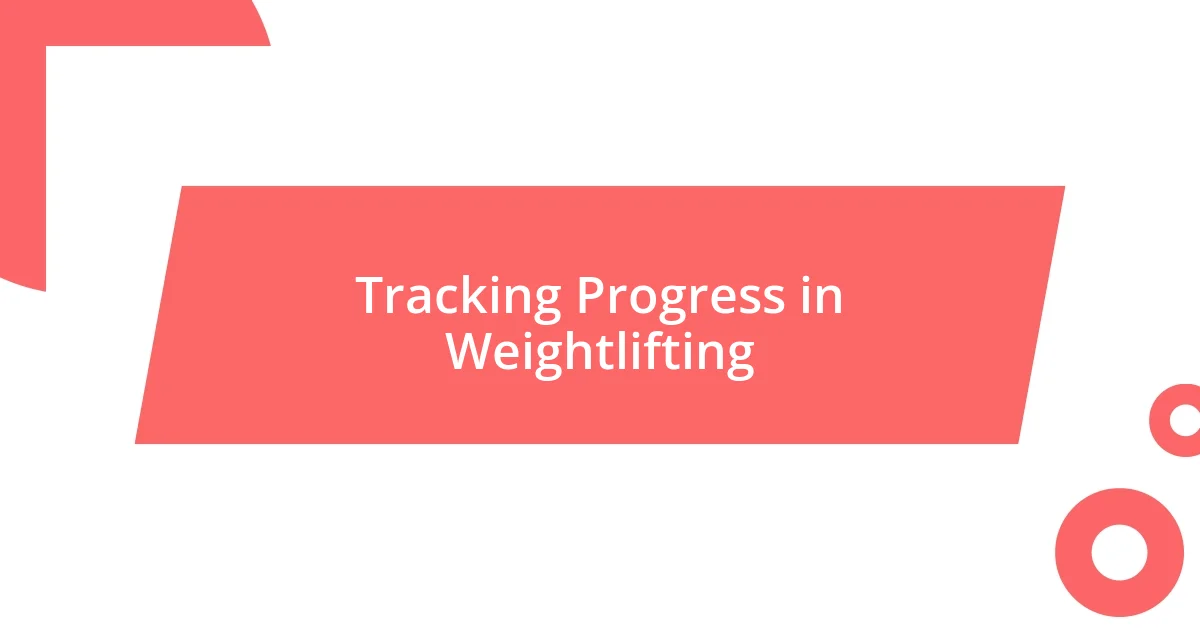Key takeaways:
- Weightlifting is a mental and physical journey; resilience and commitment are crucial for success.
- Key principles include progressive overload, consistency, nutrition, rest, and mind-muscle connection to enhance performance and prevent injuries.
- Setting realistic, measurable goals using the SMART criteria helps maintain motivation and track progress effectively.

Understanding My Weightlifting Journey
Reflecting on my weightlifting journey brings back a whirlwind of memories. I remember stepping into the gym for the first time, feeling a mix of excitement and anxiety. Who would have thought that those initial hesitant lifts would transform into a passion for strength training?
As I progressed, I learned that weightlifting is not just about physical strength; it’s a mental game as well. There were days when I felt defeated, staring at the weights as if they were mocking me. I questioned my dedication and often wondered, “Am I really cut out for this?” But each time I pushed through, I discovered a renewed sense of commitment that deepened my understanding of resilience.
I vividly recall the moment everything clicked—hitting a personal best during a particularly grueling session. The rush of accomplishment washed over me, and I felt that all the sweat and effort were worth it. Isn’t it fascinating how a single moment can redefine our motivation and perspective? That experience shaped my appreciation for the journey, reminding me that every small victory contributes to the larger goal.

Key Principles of Effective Weightlifting
Weightlifting effectively relies on a few key principles that I’ve learned through trial and error. I remember the first time I attempted a deadlift; my form was questionable. After realizing that proper technique is crucial, I made it a point to prioritize learning the right movements before chasing heavier weights. The confidence I gained as I focused on form not only prevented injuries but also improved my performance significantly.
Here are some essential principles to keep in mind:
- Progressive Overload: Gradually increase the weight, reps, or intensity of your workouts to continually challenge your muscles.
- Consistency: Stick to a regular lifting schedule. I find that the results come when you commit to your training routine, even on days when motivation dips.
- Proper Nutrition: Fuel your body with the right nutrients. I’ve found that balanced meals help my recovery and energy levels.
- Rest and Recovery: Don’t underestimate the importance of recovery days. They are just as critical for gains as the lifting itself.
- Mind-Muscle Connection: Focus on the muscle you’re training. This mental engagement has helped me maximize my workouts and feel more connected to my strength training.

Setting Realistic Weightlifting Goals
Setting realistic weightlifting goals is crucial for maintaining motivation and tracking progress. When I first started, I remember setting an ambitious target of lifting double my body weight within a few months. It was exhilarating to dream big, but I soon learned that a more measured approach would yield better results. I now believe that goals should be specific, achievable, and timely. Instead of lofty dreams, I focus on gradual improvements, such as increasing my squat by five pounds each month. It feels sustainable and rewarding.
One practical way to set these realistic goals is to break them down into smaller, manageable steps. I once set a goal to improve my bench press. Instead of solely focusing on the end target, I included mini-goals, like mastering my form or increasing my reps. Each small win provided a sense of accomplishment that fueled my motivation. Celebrating those incremental gains has made the journey enjoyable rather than overwhelming.
For anyone embarking on their weightlifting journey, I highly recommend using the SMART criteria—Specific, Measurable, Achievable, Relevant, and Time-bound. For example, rather than saying, “I want to lift heavier,” I’d frame it as, “I want to increase my deadlift by 10 pounds in the next month.” This clarity not only guides your training but also helps track progress. It has completely changed how I approach my workouts, making each session feel focused and directed.
| Aspect | SMART Goal |
|---|---|
| Specific | Increase deadlift weight. |
| Measurable | Add 10 pounds to my current max. |
| Achievable | Weight increase based on past progress. |
| Relevant | Goal aligns with my overall strength training objectives. |
| Time-bound | Achieve this within one month. |

Essential Techniques for Better Lifting
One technique that has transformed my lifting game is focusing on my grip. I used to underestimate how crucial a strong grip is, but once I started implementing exercises like farmer’s walks, I noticed a dramatic improvement in my overall lifts. Have you ever struggled to maintain control during a heavy deadlift? That was me until I realized that a firm grip not only stabilizes the weight but also boosts my confidence when facing heavier loads.
Another essential technique is the use of breathing patterns. I’ve learned that timing my breaths correctly can make all the difference when lifting heavy weights. Inhale deeply before initiating a lift and exhale at the top; this has significantly increased my core stability. It’s fascinating how something so simple can impact performance. I often catch myself reminding others to pay attention to their breath—it’s truly a game changer.
Finally, I can’t stress enough the importance of warming up properly. I used to skip my warm-up, thinking it was just a waste of time, but I quickly learned that this added time in the gym is critical. I now dedicate at least 10 minutes to dynamic stretches and light sets. The difference in my performance is palpable, and I feel more energized rather than fatigued before I even begin my main lifts. Have you ever experienced that refreshing feeling after a good warm-up? It’s worth making it a non-negotiable part of your routine.

Nutrition That Supports Weightlifting
Nutrition plays a pivotal role in my weightlifting journey, and I can’t emphasize enough how it impacts performance. For me, starting the day with a balanced breakfast, filled with protein, healthy fats, and complex carbs, sets the tone for my workouts. I remember a time when I skipped breakfast, thinking the extra hours would boost my performance. Instead, I felt drained and struggled to lift even half my usual weight. Now, I never miss a morning meal because it energizes me, both physically and mentally.
Hydration is another critical element that I often overlooked in the past. I used to rely on water sporadically, thinking I was fine because I wasn’t thirsty. However, I learned my lesson the hard way during a particularly tough leg day. Halfway through my workout, I cramped up, and it was a stark reminder that staying hydrated is essential for optimal performance. I’ve since made it a habit to drink at least a liter of water before hitting the gym, and I feel a noticeable difference in my stamina and strength.
I’ve discovered that incorporating post-workout nutrition can significantly improve recovery. Initially, I didn’t think about what I consumed after lifting; I would just grab whatever was convenient. Then, after a grueling session, I felt sore and fatigued for days. Now, I focus on a combination of protein and carbs within 30 minutes of my workout. A chocolate protein shake with a banana has become a go-to for me. This strategy not only helps with muscle recovery but also keeps my energy levels high for the day ahead. How do you feel after a workout? Trust me, refining your nutrition can make all the difference!

Tracking Progress in Weightlifting
Tracking progress in weightlifting is crucial for seeing improvements and maintaining motivation. I remember when I first started lifting—I would just show up and lift without much thought. But, once I began documenting my lifts in a notebook, I became more aware of my progression. Seeing the weights gradually increase over weeks was such a rewarding experience. It made me realize how important it is to celebrate even small wins in my journey.
I’ve also found that using apps specifically designed for tracking workouts has elevated my experience. Recently, I switched to one that allows me to log sets, reps, and even my mood during workouts. I didn’t think much of it at first, but looking back at my entries really shows how my mental state affects my lifting performance. Have you ever felt more energetic one day than another? These insights can be game-changers when planning future workouts.
Even more, I’ve learned that setting both short-term and long-term goals can significantly boost my focus and performance. When I set a specific goal, like hitting a certain weight for my squat, I find myself more committed during workouts. I still vividly remember the day I achieved my goal; the rush of excitement was unlike anything else. It’s an exhilarating feeling to see how I’ve grown. What goals have you set for yourself in your lifting journey? Sharing these milestones keeps us accountable and motivated!

Overcoming Common Weightlifting Challenges
When it comes to overcoming common weightlifting challenges, I’ve faced my fair share of obstacles. For instance, I distinctly remember struggling with plateaus. There was a time when I couldn’t seem to increase my bench press despite all my efforts. It became frustrating, and I questioned my abilities. However, after reaching out to a coach for advice, I learned the power of variation. Introducing different rep ranges and exercises helped shock my muscles into growth again, reminding me that sometimes all you need is a fresh approach.
Another challenge I’ve encountered is self-doubt, especially on days when I feel fatigued or off. I recall a particularly tough training session when I felt like I’d never lift my usual weights. Instead of pushing through, I chose to focus on my form and embraced lighter weights, which ultimately led to more effective training. I discovered that adjusting my mindset allowed me to appreciate the process and develop resilience. Have you ever found yourself second-guessing your capabilities? It’s vital to acknowledge those feelings and turn them into opportunities for growth.
Lastly, fatigue can be a big hurdle. Initially, I struggled to maintain energy throughout my workouts, often feeling sluggish as I neared the end. Then I adopted the practice of structured rest days and lighter recovery workouts. I still remember the first week I tried this protocol; I was amazed at how much stronger I felt during my intense sessions! Learning that rest is just as important as lifting has transformed my approach to training. Have you considered how your recovery impacts your performance? Trust me, tuning into your body can open up new doors in your lifting journey.












